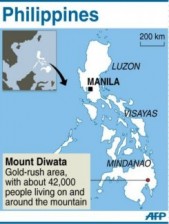Ore-crushing plants on Mt. Diwata to be relocated
 DAVAO CITY, Philippines – The regional office of the Mines and Geosciences Bureau in Southern Mindanao has directed the transfer of gold-ore-crushing and processing facilities on Mt. Diwata in Monkayo, Compostela Valley, to stanch the pollution of the Naboc River, an important source of water for farming in the province, with mercury and other contaminants.
DAVAO CITY, Philippines – The regional office of the Mines and Geosciences Bureau in Southern Mindanao has directed the transfer of gold-ore-crushing and processing facilities on Mt. Diwata in Monkayo, Compostela Valley, to stanch the pollution of the Naboc River, an important source of water for farming in the province, with mercury and other contaminants.
Edilberto Arreza, MGB regional director, said the ball mills and batch processing plants would be moved to the Mineral Processing Zone in Barangay Mabatas, also in Monkayo, which has a 9-year-old tailings containment facility that needs, however, to be rehabilitated first.
The transfer of the ore-crushing facilities to Mabatas, which the MGB will oversee, would eliminate direct discharges of mine talings or wastes to the Naboc River and other waterways, Arreza told reporters here recently.
The Mabatas dam was built by the Department of Environment and Natural Resources and the Philippine Mining Development Corp., a state corporation overseeing the operations of small-scale miners in Compostela Valley, at a cost of P20 million in 2003. But it was never used for gold ore processing by small-scale miners, who continue to use their facilities in Mt. Diwata, he said.
Arreza said the transfer of the gold ore processing plants to Mabatas could start as soon as PDMC finishes rehabilitating the dam, but he gave no indication how long this would take.
Arreza said that by the time the rebilitation work would be completed, the MGB would also have completed its information drive on the need to relocate the facilities.
Unless the plants were transferred, Arreza said, the mercury contamination of the Naboc River would worsen.
The Naboc River supplies irrigation water to rice fields in Compostela Valley.
Arreza said the latest water quality assessment showed that the river’s total copper content exceeded the standard of 0.05 milligrams per liter set by the DENR’s Administrative Order 34. Mercury contamination was at 1.25 mg per liter, a sharp increase from previous reading of 0.05 mg/l, he said.
The volume of suspended solids at four monitoring stations was also high although test results for cyanide were within standards, Arreza said.
Mt. Diwata is not a declared Minahang Bayan area although small-scale miners operate there under government supervision.
Arreza said that Mt. Diwata, also known as Mt. Diwalwal, could not be declared a Minahang Bayan site since it was a mineral reservation open to large-scale mining.














